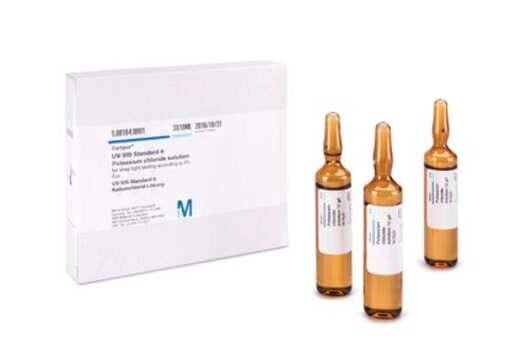1.04865
Potassium dichromate
for analysis (max. 0.000001% Hg) EMSURE® ACS,ISO
Synonyme(s) :
Potassium dichromate, Potassium bichromate, Potassium pyrochromate
About This Item
Produits recommandés
Qualité
ACS reagent
Niveau de qualité
Agence
reag. ISO
Gamme de produits
EMSURE®
Pureté
≥99.9% (iodometric)
Forme
crystalline
Puissance
90.5 mg/kg LD50, oral (Rat)
1170 mg/kg LD50, skin (Rat)
Impuretés
≤0.005% Insoluble matter
Perte
≤ 0.05% loss on drying, 105°C
pH
3.6 (100 g/L in H2O)
Point d'ébullition
>500 °C/1013 hPa
Pf
398 °C
Densité
2.7 g/cm3 at 20 °C
Masse volumique apparente
1250 kg/m3
Traces d'anions
chloride (Cl-): ≤0.001%
sulfate (SO42-): ≤0.005%
Traces de cations
Ca: ≤0.002%
Cu: ≤0.001%
Fe: ≤0.001%
Hg: ≤0.000001%
Na: ≤0.02%
Pb: ≤0.005%
Température de stockage
2-30°C
InChI
1S/2Cr.2K.7O/q;;2*+1;;;;;;2*-1
Clé InChI
KMUONIBRACKNSN-UHFFFAOYSA-N
Catégories apparentées
Application
- Coupling of gene regulation and carrier modification manipulates bacterial biofilms as robust living catalysts: This research explores the application of potassium dichromate as a catalyst in biotechnological processes, particularly in the modification of bacterial biofilms. These developments show significant promise for bioengineering, where robust living catalysts can play critical roles in industrial bioprocessing and environmental remediation (Yan CH et al., 2024).
- Exploring the synergistic effect of chromium (Cr) tolerant Pseudomonas aeruginosa and nano zero valent iron (nZVI) for suppressing Cr uptake in Aloe Vera: This study uses potassium dichromate to investigate the effects of chromium exposure on plants and the potential mitigating actions of bioremediation techniques. It highlights the importance of using potassium dichromate in environmental science to assess and develop strategies for managing heavy metal contamination in agriculture (Komal et al., 2024).
- Preparation and properties of oxidized multi-walled carbon nanotube superhydrophobic composites modified by bio-fatty acids: Potassium dichromate is used here as an oxidizing agent in the synthesis of advanced nanocomposite materials. These materials are significant for their applications in creating superhydrophobic surfaces, which have broad implications in material science and industrial manufacturing, particularly for coatings and environmental applications (Hao X et al., 2024).
- An internal filtration effect-based "off-on" probe for fluorescent and visual sensing of formaldehyde: In this research, potassium dichromate′s role as a chemical reagent in analytical methods is highlighted. It is used to develop sensitive and specific sensors for detecting hazardous substances like formaldehyde, underscoring its critical role in enhancing public health and safety protocols within laboratory and industrial settings (Fan W et al., 2024).
Remarque sur l'analyse
Insoluble matter: ≤ 0.005 %
Chloride (Cl): ≤ 0.001 %
Sulfate (SO₄): ≤ 0.005 %
Ca (Calcium): ≤ 0.002 %
Cu (Copper): ≤ 0.001 %
Fe (Iron): ≤ 0.001 %
Hg (Mercury): ≤ 0.000001 %
Na (Sodium): ≤ 0.02 %
Pb (Lead): ≤ 0.005 %
Loss on Drying (105°C): ≤ 0.05 %
Informations légales
Mention d'avertissement
Danger
Classification des risques
Acute Tox. 2 Inhalation - Acute Tox. 3 Oral - Acute Tox. 4 Dermal - Aquatic Acute 1 - Aquatic Chronic 1 - Carc. 1B - Eye Dam. 1 - Muta. 1B - Ox. Sol. 2 - Repr. 1B - Resp. Sens. 1 - Skin Corr. 1B - STOT RE 1 Inhalation - STOT SE 3
Organes cibles
Cardio-vascular system, Respiratory system
Code de la classe de stockage
5.1B - Oxidizing hazardous materials
Classe de danger pour l'eau (WGK)
WGK 3
Point d'éclair (°F)
Not applicable
Point d'éclair (°C)
Not applicable
Listes réglementaires
Les listes réglementaires sont principalement fournies pour les produits chimiques. Seules des informations limitées peuvent être fournies ici pour les produits non chimiques. L'absence d'indication signifie qu'aucun des composants n'est répertorié. Il incombe à l'utilisateur de s'assurer de l'utilisation sûre et légale du produit.
EU REACH SVHC Candidate List
EU REACH Annex XVII (Restriction List)
EU REACH Annex XIV (Authorisation List)
Certificats d'analyse (COA)
Recherchez un Certificats d'analyse (COA) en saisissant le numéro de lot du produit. Les numéros de lot figurent sur l'étiquette du produit après les mots "Lot" ou "Batch".
Déjà en possession de ce produit ?
Retrouvez la documentation relative aux produits que vous avez récemment achetés dans la Bibliothèque de documents.
Les clients ont également consulté
Notre équipe de scientifiques dispose d'une expérience dans tous les secteurs de la recherche, notamment en sciences de la vie, science des matériaux, synthèse chimique, chromatographie, analyse et dans de nombreux autres domaines..
Contacter notre Service technique










